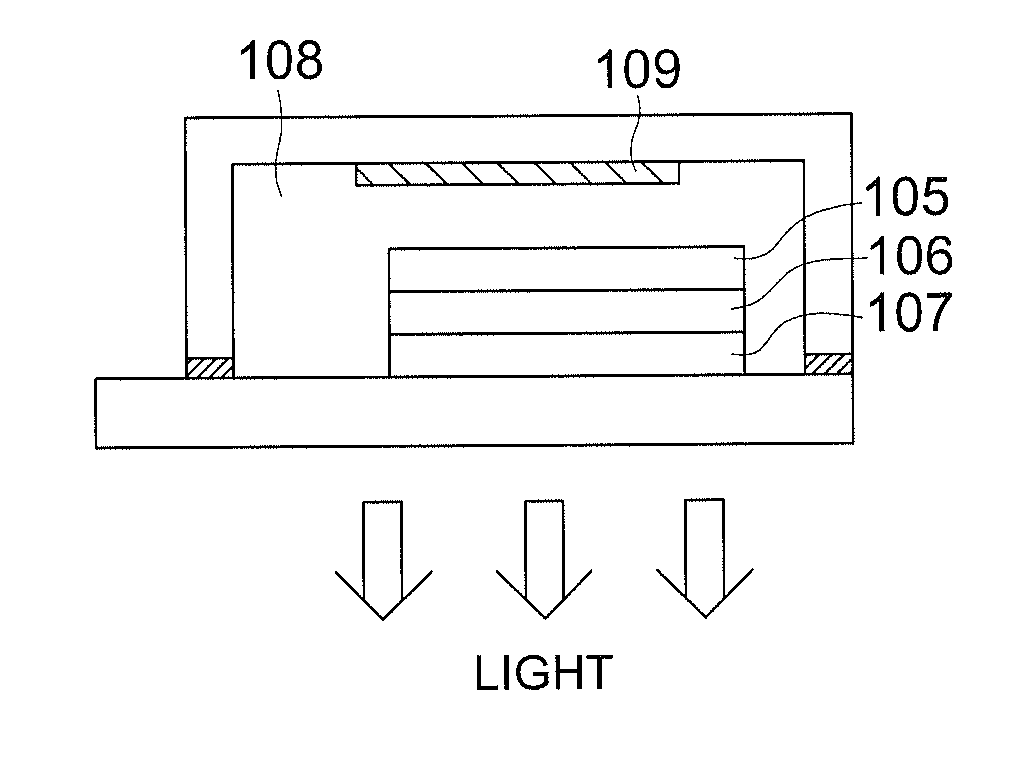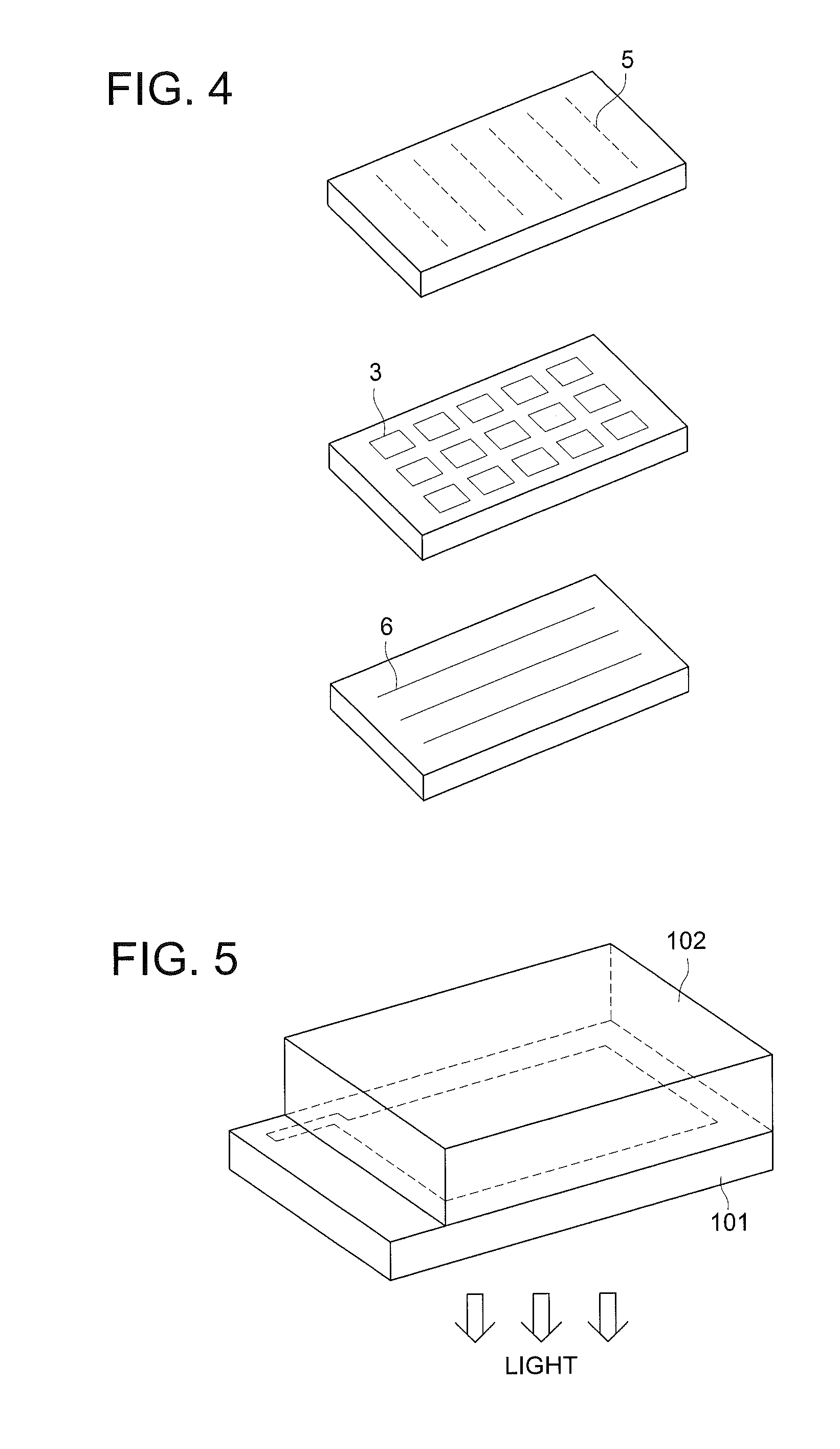Organic electroluminescent element, display device, illuminating device and condensed polycyclic heterocyclic compound
a technology of electroluminescent elements and heterocyclic compounds, applied in the direction of organic semiconductor devices, thermoelectric devices, organic chemistry, etc., can solve the problem of insufficient efficiency of other luminescent colors, and achieve the effect of high external quantum efficiency, long life and high light emitting efficiency
- Summary
- Abstract
- Description
- Claims
- Application Information
AI Technical Summary
Benefits of technology
Problems solved by technology
Method used
Image
Examples
example 1
Preparation of Organic EL Elements 1-1 to 1-20
[0165]An anode was prepared by making patterning to a glass substrate of 100 mm×100 mm×1.1 mm (NA45 produced by NH Techno Glass Corp.) on which a 100 nm film of ITO (indium tin oxide) was formed. Thereafter, the above transparent support substrate provided with the ITO transparent electrode was subjected to ultrasonic washing with isopropyl alcohol, followed by drying with desiccated nitrogen gas, and was subjected to UV ozone washing for 5 minutes.
[0166]This transparent support substrate was fixed to the substrate holder of a commercial vacuum deposition apparatus. On the other hand, the following were each individually placed in a resistance heating boat made of molybdenum: 200 mg of α-NPD, 200 mg of CBP as a host compound, 200 mg of bathocuproine (BCP), 100 mg of D-038, and 200 mg of Alq3. They were fitted in the vacuum deposition apparatus.
[0167]Subsequently, after reducing the pressure of the vacuum chamber to 4×10−4 Pa, the aforesa...
example 2
Preparation of Organic EL Elements 2-1 to 2-16
[0176]An anode was prepared by making patterning to a glass substrate of 100 mm×100 mm×1.1 mm (NA45 produced by NH Techno Glass Corp.) on which a 100 nm film of ITO (indium tin oxide) was formed. Thereafter, the above transparent support substrate provided with the ITO transparent electrode was subjected to ultrasonic washing with isopropyl alcohol, followed by drying with desiccated nitrogen gas, and was subjected to UV ozone washing for 5 minutes.
[0177]This transparent support substrate was fixed to the substrate holder of a commercial vacuum deposition apparatus. On the other hand, the following were each individually placed in a resistance heating boat made of molybdenum: 200 mg of α-NPD, 200 mg of CBP, 200 mg of BCP as a hole blocking compound, 100 mg of Ir-1, and 200 mg of Alq3. They were fitted in the vacuum deposition apparatus.
[0178]Subsequently, after reducing the pressure of the vacuum chamber to 4×104 Pa, the aforesaid heatin...
example 3
Preparation of Organic EL Elements 3-1 to 3-8
[0186]Organic EL elements 3-1 to 3-8 each were prepared in the same manner as preparation of Organic EL element 1-1, except that the host compound in the light emitting layer was replaced with each of the compounds as listed in the following table, D-038 was replaced with Ir-1, and BCP in the hole blocking layer was replaced with B-Alq.
Evaluation of Organic EL Elements 3-1 to 3-8
[0187]Evaluation of aging stability was done according to the measuring method shown below,
(Aging Stability)
[0188]Each Organic EL element was kept at aging condition of 85° C. for 24 hours. The luminance for each of Organic EL elements before aging and after aging driven at a constant current of 2.5 mA / cm2 was measured. Luminance ratios of before aging and after aging were measured according to the following formula. These value were used for evaluating aging stability.
Aging stability (%)=(Luminance after kept at aging condition (2.5 mA / cm2) / Luminance before kept ...
PUM
| Property | Measurement | Unit |
|---|---|---|
| quantum efficiency | aaaaa | aaaaa |
| quantum efficiency | aaaaa | aaaaa |
| quantum efficiency | aaaaa | aaaaa |
Abstract
Description
Claims
Application Information
 Login to View More
Login to View More - R&D
- Intellectual Property
- Life Sciences
- Materials
- Tech Scout
- Unparalleled Data Quality
- Higher Quality Content
- 60% Fewer Hallucinations
Browse by: Latest US Patents, China's latest patents, Technical Efficacy Thesaurus, Application Domain, Technology Topic, Popular Technical Reports.
© 2025 PatSnap. All rights reserved.Legal|Privacy policy|Modern Slavery Act Transparency Statement|Sitemap|About US| Contact US: help@patsnap.com



